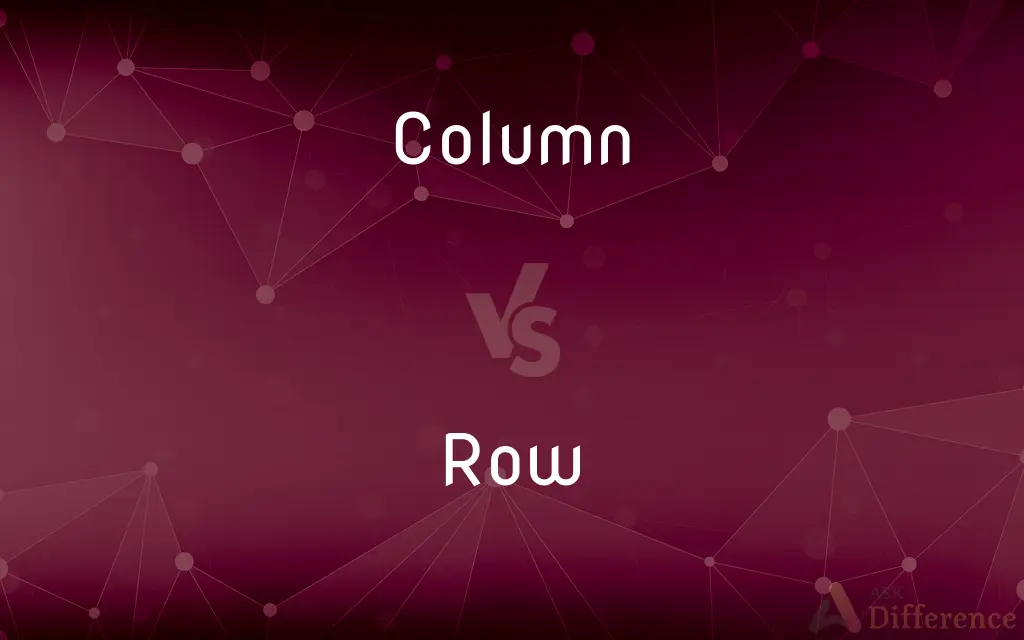Column vs. Row — What's the Difference?
By Tayyaba Rehman & Fiza Rafique — Updated on March 2, 2024
A column is a vertical arrangement of data or elements, often used in tables and spreadsheets, while a row is a horizontal arrangement, highlighting the contrast in orientation and data presentation.

Difference Between Column and Row
Table of Contents
ADVERTISEMENT
Key Differences
A column is typically used to represent a specific type of data across different entries in a database, spreadsheet, or table, such as names or prices. This vertical arrangement allows for easy comparison and sorting of data based on the column's attribute. Whereas, a row represents a single record or entry, containing various attributes or fields of data horizontally. This facilitates understanding the relationship between different data points of an entry.
Columns are often referred to by letters in spreadsheets (e.g., A, B, C) or names in databases and tables, signifying their role in categorizing data under specific headings. On the other hand, rows are usually identified by numbers, indicating their sequence and facilitating reference to a particular dataset's entire entry.
Data manipulation and retrieval, columns facilitate operations like sorting and filtering, enabling users to organize data based on the values of one or more columns. Whereas rows are crucial for operations such as search queries, where the aim is to retrieve or manipulate the complete dataset of a single record.
The design and structure of columns and rows are essential in relational databases, where the efficient organization of data can significantly impact performance. Columns in databases are designed to hold minimal data types to reduce storage requirements and improve retrieval speed, while rows are structured to ensure that all data for a specific record is accessible together, optimizing data integrity and transaction processing.
When working with data analysis and reporting, understanding the distinction between columns and rows is fundamental. Columns allow for the analysis of trends over time or comparisons among categories, while rows provide a snapshot of all data points for an individual record or entity, showcasing the breadth of information available for analysis.
ADVERTISEMENT
Comparison Chart
Orientation
Vertical
Horizontal
Purpose
Represents types of data across entries
Represents a single record or entry
Identification
Often by letters (A, B, C) or names
Usually by numbers
Data Manipulation
Facilitates sorting and filtering
Crucial for search queries and complete data retrieval
Analysis Use
Used for trend analysis and comparisons
Provides a snapshot of data for an individual record
Compare with Definitions
Column
A cylindrical object or feature.
A column of smoke rose from the chimney.
Row
A horizontal series of data or items in a table, spreadsheet, or list.
Each row in the spreadsheet represents a different transaction.
Column
A regular section in a newspaper or magazine devoted to a particular subject or written by a particular person.
She writes a weekly column on local history.
Row
A linear arrangement of objects or plants.
The garden had rows of flowers and vegetables.
Column
A vertical series of cells in a chart, table, or spreadsheet.
The 'Price' column lists all product prices.
Row
A quarrel or dispute.
They had a row over who should wash the dishes.
Column
A structural element in architecture that supports weight above it.
The ancient Greeks used columns extensively in their temples.
Row
A line of seats in a theater, cinema, or classroom.
We sat in the front row during the lecture.
Column
A vertical division of a page or text.
The layout uses two columns to maximize space.
Row
A series of people or things lined up.
The team stood in a row for the national anthem.
Column
A column or pillar in architecture and structural engineering is a structural element that transmits, through compression, the weight of the structure above to other structural elements below. In other words, a column is a compression member.
Row
A series of objects placed next to each other, usually in a straight line.
Column
A vertical structure usually consisting of a base, a cylindrical shaft, and a capital, used as a support or standing alone as a monument.
Row
A succession without a break or gap in time
Won the title for three years in a row.
Column
A vertical glass tube used in column chromatography; a mixture is poured in the top and washed through a stationary substance where components of the mixture are adsorbed selectively to form colored bands
Row
A line of adjacent seats, as in a theater, auditorium, or classroom.
Column
A vertical structure standing alone and not supporting anything (as a monument or a column of air)
Row
A continuous line of buildings along a street.
Common Curiosities
What is a column?
A column is a vertical arrangement of data in a table or spreadsheet, categorizing information under a specific heading.
How are rows identified?
Rows are usually identified by numbers, indicating their sequence.
What is a row?
A row is a horizontal arrangement of data, representing a single record or entry with various data points.
How are columns identified?
Columns are typically identified by letters (in spreadsheets) or names (in databases).
Can a single data point belong to both a column and a row?
Yes, a single data point is part of both a column and a row, representing a specific attribute of a record.
How do columns and rows facilitate data analysis?
Columns allow for trend analysis and comparisons, while rows provide complete snapshots of individual records.
Why are rows important in databases?
Rows represent individual records, crucial for retrieving complete data sets and performing transactions.
How do columns and rows affect data visualization?
They determine the layout of data in charts, graphs, and tables, affecting interpretability.
Are columns and rows relevant in non-digital data presentation?
Yes, they are fundamental in organizing data in any medium, including paper charts and ledgers.
Can rows and columns be added or removed easily in databases and spreadsheets?
Yes, most database and spreadsheet software allow for the dynamic modification of rows and columns.
Why are columns important in databases?
Columns categorize data, making it easier to sort, filter, and perform analyses.
What role do columns and rows play in spreadsheets?
They organize data, making it easier to manage, analyze, and present information.
What is the difference between a row and a line?
A row specifically refers to a horizontal arrangement of data or items, while a line can be any linear arrangement, not necessarily data-related.
Can the orientation of columns and rows be changed?
While the orientation is typically fixed, data can be transposed to switch columns and rows in some software.
How does the concept of rows and columns apply to programming?
In programming, they structure data in arrays, matrices, and other data structures for efficient processing.
Share Your Discovery

Previous Comparison
Coo vs. Cop
Next Comparison
Canine vs. FelineAuthor Spotlight
Written by
Tayyaba RehmanTayyaba Rehman is a distinguished writer, currently serving as a primary contributor to askdifference.com. As a researcher in semantics and etymology, Tayyaba's passion for the complexity of languages and their distinctions has found a perfect home on the platform. Tayyaba delves into the intricacies of language, distinguishing between commonly confused words and phrases, thereby providing clarity for readers worldwide.
Co-written by
Fiza RafiqueFiza Rafique is a skilled content writer at AskDifference.com, where she meticulously refines and enhances written pieces. Drawing from her vast editorial expertise, Fiza ensures clarity, accuracy, and precision in every article. Passionate about language, she continually seeks to elevate the quality of content for readers worldwide.
















































